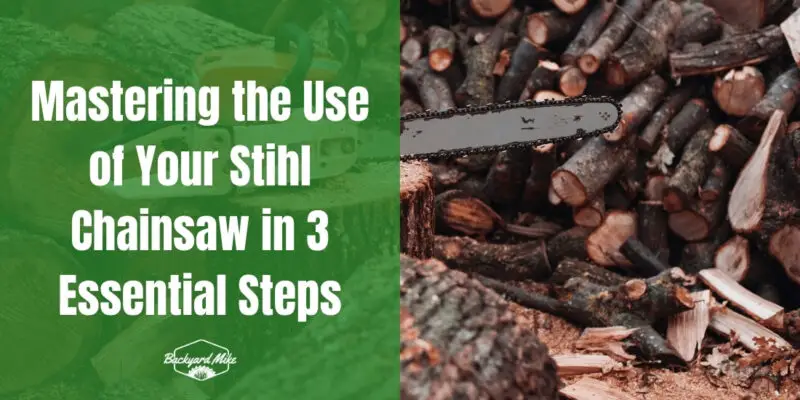Mastering your Stihl chainsaw involves three essential steps. First, guarantee thorough preparation: inspect the chain, sharpen it, and check fuel levels. Then, focus on operation: wear safety gear, engage the chain brake, and maintain control. Finally, practice post-operation maintenance: clean the chain area, inspect for damage, and store it properly. Follow these steps for peak performance and safety. By focusing on these essentials, you'll be well-equipped to use your chainsaw effectively.
Key Takeaways
- Inspect the chainsaw for damages and ensure proper tension before use.
- Wear appropriate safety gear and inspect the environment for hazards before starting the chainsaw.
- Utilize correct cutting techniques, beginning with side cuts and adjusting chain tension for optimal performance.
- Perform post-operation maintenance by cleaning debris and checking for broken parts.
- Store the chainsaw in a dry, ventilated area, emptying the fuel tank for long-term storage.
Preparing Your Chainsaw for Safe and Efficient Use
Before you start using your Stihl chainsaw, it's essential to guarantee it's prepared for safe and efficient operation.
Start with a thorough chain inspection to check for any damage and verify proper tension. This step guarantees safety and peak performance, helping you feel confident and connected to a community of responsible chainsaw users. A dull chainsaw can produce finer sawdust instead of large uniform chips, indicating the need for sharpening to ensure optimal cutting performance. Stihl chainsaws are equipped with innovative safety features that enhance user protection, making them a reliable choice for both novice and experienced users.
Next, perform a fuel check to confirm that both the fuel and bar oil levels are adequate. This guarantees your chainsaw runs smoothly, allowing you to focus on your tasks without interruptions.
Operating Your Chainsaw With Precision and Care
With your Stihl chainsaw properly prepared, it's time to operate it with precision and care. First, prioritize chainsaw safety by choosing the right gear for the job. Engage the chain brake before starting, and use the correct starting techniques specific to your model. Maintain balance and control during operation by keeping the chainsaw close to your body. Always inspect your environment for hazards, guaranteeing a safe workspace. Remember to avoid drop starting the chainsaw to prevent accidents and ensure a safe operation. Master cutting techniques by using the top or bottom of the chain for greater control. Begin with side cuts when working on logs and branches, and utilize the chain's center for thicker cuts to minimize kickback. Chainsaw chaps are essential protective gear that can prevent life-threatening injuries during operation. Adjust the chain tension before each use to guarantee an ideal cut, keeping your chainsaw in top condition.
Post-Operation Maintenance and Storage Practices
Once you've finished using your Stihl chainsaw, it's essential to perform thorough post-operation maintenance to guarantee its longevity and safe performance.
Start with a maintenance checklist: inspect for broken or missing parts, check the air filter, and verify the starter rope's condition. Examine the chainsaw for wear, ensuring safety features are intact.
Inspect for broken parts, check the air filter, and verify the starter rope's condition for optimal performance.
Clean the bar and chain area, using a toothbrush to remove debris. Maintain the chain by sharpening or replacing it, checking tension, and lubricating it. Ensure oil delivery holes are unclogged for effective lubrication, as this is crucial for maintaining optimal performance and preventing damage to the chainsaw.
For storage tips, store your chainsaw in a well-ventilated area, away from sunlight. Empty the fuel tank if storing long-term, and keep tools organized. Selecting the right chainsaw sharpener can improve the cutting experience significantly, as a sharp chain is essential for both performance and safety.
Dry the chainsaw thoroughly to protect against moisture, ensuring it's ready for future use.
Frequently Asked Questions
How Do I Troubleshoot a Chainsaw That Doesn't Start?
To troubleshoot a chainsaw that won't start, check the chainsaw fuel levels and mixture, inspect for starter issues like a worn rope, and make certain the spark plug and ignition are working. You're part of a community that supports you!
What Are the Signs of a Worn-Out Chainsaw Chain?
A stitch in time saves nine. You'll notice chain tension issues, decreased cutting performance, and fine sawdust instead of chips. Regularly check for dullness, uneven teeth, or damage to guarantee your chainsaw family stays sharp and effective.
Can I Use Any Type of Oil for Chain Lubrication?
You can't just use any oil type for chain lubrication. It's essential for efficiency and longevity. Stick with recommended oils, ensuring proper lubrication importance. Align with fellow chainsaw enthusiasts by following guidelines for best performance and belonging.
How Often Should I Replace the Chainsaw Spark Plug?
Who knew spark plugs weren't eternal? You should replace them annually or follow your chainsaw's maintenance schedule. Embrace the ritual and keep your chainsaw community-ready with a well-maintained spark plug lifespan, ensuring smooth performance for all.
What Should I Do if My Chainsaw Overheats?
If your chainsaw overheats, stop immediately and let it cool. Inspect for overheating causes: check the air filter and fuel mix. Regular chainsaw maintenance fosters community among users, ensuring your tool runs smoothly and safely.
Conclusion
You've learned the essentials to master your Stihl chainsaw. First, make certain it's prepared for safe, efficient use. Then, operate it with precision, focusing on control and safety. Finally, maintain and store your chainsaw properly after each use. Each step is vital, so don't overlook any detail. As you stand ready to tackle your next project, remember that mastery lies in the details. Will you rise to the challenge, guaranteeing safety and efficiency every time?


